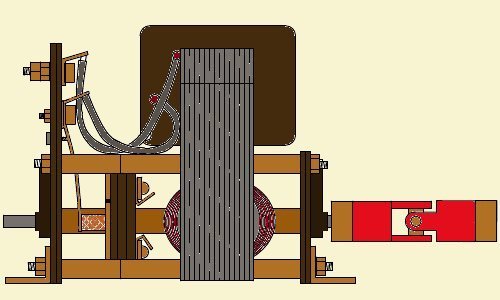These motors were made by a small engineering company on the south coast of England, run by Messrs Taylor and Collis, and were popular in UK model shops between about 1950-1970. This site provides a quick overview and some installation information about them, in the hope that this will encourage their continued use in vintage craft...
Modellers may sometimes come across what looks nowadays like an odd item of machinery. An open-frame motor made of iron, brass and paxolin, with very distinctive coil(s) of (usually) red varnished copper wire attached to the frame.
It will be very heavy due the solid mass of iron and copper, as well as the thick brass spacers holding the paxolin plates apart. It will have a mass of wiring connectors on one end-plate and, if you are lucky, a stamped name on the end-plates or brass feet. If it's attached to the propeller shaft of an old model boat, there is a good chance that this is an open-frame field-wound electric motor for model boats from the British manufacturer Taycol.
Why a field-wound motor?
We usually associate small electric motors with DC supplies and permanent magnets. This has not always been the case.
Though Faraday originally demonstrated the motor effect with DC current back in 1830, poor battery technology held DC motor development back, and the early practical motors tended to be commercial AC units, which became available around 1890, and were typically field-wound to generate the required rotating magnetic field. Early DC motors also suffered from a lack of understanding of the magnetic flux circuit, and from the low performance of permanent magnets of the time, so that it was not unusual for electric motors to be unreliable starters – you will find comments in adverts of the time extolling the starting reliability of market-leading motors like the ‘Mighty Midget’ up to the late 1950s.
Before about 1900 small DC electric motors were primarily curiosities.
This site gives a good example of middle and late 1800s electric motor technology. You can see that field windings are the norm, and that little consideration is given to channeling the magnetic flux properly...
As more practical batteries were developed in the 1930s with the advent of radio, small DC motors also became practical. The first permanent magnets were soft iron, giving a fairly poor performance. This was superseded by the Aluminium/Nickel/Cobalt (AlNiCo) alloys, which were invented in the 1930s but became available for motors in the 1940s. By the 1960s Ferrite magnets were deposing AlNiCo magnets, and by 1975 the first of the 'super magnet' materials, Samarium Cobalt (Sm-Co) was on the market. Expensive, it didn't really spread to the cheaper motors, and in 1983 our cheaper current leader, the Neodymium Iron Boron magnet (NdFeB) was invented.
The choice of magnet material is constrained by a number of factors. Cost and availability, of course, as well as the magnetic strength the material can achieve. Whether the material retains its strength over time is important, as is its capability of coping with high temperatures. Machineability and other factors such as toxicity and corrosion resistance also come into the equation. All these factors vary month by month as advances occur, so the table below provides illustrative data rather than a precise timeline. For instance, AlNiCo is still used for magnets in some applications, though rarely for small motors. Nevertheless, it provides a comparison of the technologies:
Each of these technologies did not immediately displace its predecessor, and up until about 1970 field-wound DC motors compared favourably with the permanent magnet competition. Before 1940 small electric motors and equivalent battery technology were not properly developed - by 1970 Ferrite was performing well and about to be superseded by much more powerful materials.
It was in this period, around 1950-1970, that Taycol thrived. Field windings could outperform permanent magnets in the medium-to-large model boat engines of the time, while the extra weight of field-coils was not a great drawback since electric boat performance of the time rarely included planning – in any case the accumulators required to store the electricity were much heavier!


